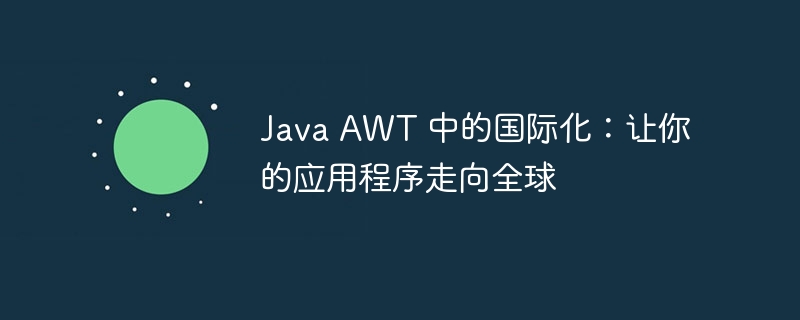Internationalization in Java AWT: Taking your application global

php Xiaobian Xigua will help you understand the internationalization in Java AWT and make your application more global. Through internationalization, applications can be made to support multiple languages and cultural practices, providing users with a more friendly experience. Master internationalization skills so that your application is no longer limited to a specific region and reaches a broader international market.
Advantages of internationalization
Internationalization can bring many benefits to your application, including:
- Expand market coverage: Supports different languages and locales, allowing you to promote your app to a wider market.
- Improve user experience: Increase user satisfaction by providing users with the application interface in their preferred language.
- Compliance: Some countries require apps to support certain languages or locales.
Java AWT Internationalization
Java AWT provides several key classes and methods to support internationalization:
- Locale Class represents a specific language and locale. The
- ResourceBundle class provides access to Translation resources stored in properties files.
- java.util.Formatter Class is used to format text to adapt it to different languages and locales.
Create properties file
The first step is to create a properties file to store translation resources. The format of the properties file is as follows:
# comment key=value
For example, a properties file for an English (en) language resource might look like this:
# English (en) resources label.name=Name label.email=Email
Load properties file
To load a properties file, use the following code:
Locale locale = new Locale("en");
ResourceBundle bundle = ResourceBundle.getBundle("resources", locale);Get translated text
You can use the following code to get the translated text from the properties file:
String nameLabelText = bundle.getString("label.name");Formatted text
Use the java.util.F<strong class="keylink">ORM</strong>atter class to format text to suit different languages and locales. For example, the following code formats a date:
Locale locale = new Locale("en");
Formatter formatter = new Formatter(locale);
String formattedDate = formatter.format("%tF", date);More Best Practices
- Keep text and code separate: Save translated text in a properties file, separate from code.
- Use UTF-8 encoding: Ensure that the properties file uses UTF-8 encoding to support various language characters.
- Test different locales: Test the application in different languages and locales to make sure it displays correctly.
-
Consider time zones: Use the
java.util.TimeZoneclass to handle different time zones.
in conclusion
By following the steps and best practices outlined in this article, you can use Java AWT to create internationalized applications that support different languages and locales. Doing so can expand your app’s market reach, improve user experience, and ensure your app complies with global regulations. As the trend of globalization continues to grow, internationalization is essential for any application developer seeking to succeed on the global stage.
The above is the detailed content of Internationalization in Java AWT: Taking your application global. For more information, please follow other related articles on the PHP Chinese website!

Hot AI Tools

Undresser.AI Undress
AI-powered app for creating realistic nude photos

AI Clothes Remover
Online AI tool for removing clothes from photos.

Undress AI Tool
Undress images for free

Clothoff.io
AI clothes remover

AI Hentai Generator
Generate AI Hentai for free.

Hot Article

Hot Tools

Notepad++7.3.1
Easy-to-use and free code editor

SublimeText3 Chinese version
Chinese version, very easy to use

Zend Studio 13.0.1
Powerful PHP integrated development environment

Dreamweaver CS6
Visual web development tools

SublimeText3 Mac version
God-level code editing software (SublimeText3)

Hot Topics
 1377
1377
 52
52
 How does Java's classloading mechanism work, including different classloaders and their delegation models?
Mar 17, 2025 pm 05:35 PM
How does Java's classloading mechanism work, including different classloaders and their delegation models?
Mar 17, 2025 pm 05:35 PM
Java's classloading involves loading, linking, and initializing classes using a hierarchical system with Bootstrap, Extension, and Application classloaders. The parent delegation model ensures core classes are loaded first, affecting custom class loa
 How do I implement multi-level caching in Java applications using libraries like Caffeine or Guava Cache?
Mar 17, 2025 pm 05:44 PM
How do I implement multi-level caching in Java applications using libraries like Caffeine or Guava Cache?
Mar 17, 2025 pm 05:44 PM
The article discusses implementing multi-level caching in Java using Caffeine and Guava Cache to enhance application performance. It covers setup, integration, and performance benefits, along with configuration and eviction policy management best pra
 How can I use JPA (Java Persistence API) for object-relational mapping with advanced features like caching and lazy loading?
Mar 17, 2025 pm 05:43 PM
How can I use JPA (Java Persistence API) for object-relational mapping with advanced features like caching and lazy loading?
Mar 17, 2025 pm 05:43 PM
The article discusses using JPA for object-relational mapping with advanced features like caching and lazy loading. It covers setup, entity mapping, and best practices for optimizing performance while highlighting potential pitfalls.[159 characters]
 How do I use Maven or Gradle for advanced Java project management, build automation, and dependency resolution?
Mar 17, 2025 pm 05:46 PM
How do I use Maven or Gradle for advanced Java project management, build automation, and dependency resolution?
Mar 17, 2025 pm 05:46 PM
The article discusses using Maven and Gradle for Java project management, build automation, and dependency resolution, comparing their approaches and optimization strategies.
 How do I create and use custom Java libraries (JAR files) with proper versioning and dependency management?
Mar 17, 2025 pm 05:45 PM
How do I create and use custom Java libraries (JAR files) with proper versioning and dependency management?
Mar 17, 2025 pm 05:45 PM
The article discusses creating and using custom Java libraries (JAR files) with proper versioning and dependency management, using tools like Maven and Gradle.




